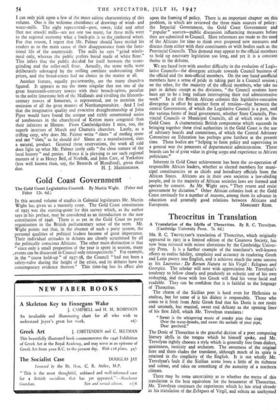Regional Memorial
Recording Britain. Volume II. (Oxford University Press, in associa- tion with the Pilgrim Trust, four volumes, not sold separately. 105s.)
THE second volume in the tragic series of recording what England has destroyed, is destroying and probably will destroy of its own selfhood covers East Anglia, the Fen Counties outside Lincolnshire and Yorkshire. For " enemy action " makes an infinitesimal contri- bution to the lavish way in which our industrial civilisation preys upon its heritage. The first volume made its public familiar with the general design of the four-volume set in which nearly a hundred artists responded to the call of the Pilgrim Trust for the work of pictorial salvage among the actual or potential ruins. Mr. Arnold Palmer has proved himself an exquisite choice for the editorial notes. Of no interpreter could it be more justly said that he carries his learning buoyantly, and the scholarship needed for commenting upon the enormous treasure of English architecture from the village masons upwards and from authentic to Victorian Gothic is positively Bodleian. Mr. Palmer's mastery of poise is what the jargonists of our day call " phenomenal " ; he sails with breath-taking address and daring between the Scylla of the facetious and the Charybdis of the academic.
The artists of this volume have made a very sound job of what by the nature of their task was in 194.2-3 a most exacting one. It is true that one does miss the transporting touch of such war-victims as Rex Whistler, Eric Ravilious and Tom Hennell, and that John Piper does rather loom among his admirable coadjutors. And, speaking for myself, I miss the name of Edward Bawden, .a richly regional delineator, in the Essex section. But the business of these artists is quite simply to make a record, not a picture gallery, and this they have done most faithfully and well.
Since brevity has become the body if not the soul of reviewing, I can only pick upon a few of the more salient characteristics of this volume. One is the welcome abundance of drawings of wind- and water-mills. The eight represented--post, tower, tidal and other (but not smock) mills--are not one too many, for these mills were to the regional economy what a linch-pin is to the timbered wheel. For that reason, I regret that Mr. Palmer should have misled his readers as to the main cause of their disappearance from the func- tional life of the countryside. The mills he says "grind whole- meal only, whereas the public prefers bread made of white flour." This infers that the public decided for itself between the stone- grinding and the roller-mill flour. Actually, the stone mills were deliberately sabotaged by the milling combine undercutting their prices, and the bread-eaters had no choice in the matter at all.
Another feature, equally praiseworthy, are the many churches figured. It appears to me the more singular that not one of the great fourteenth-century towers with their broach-spires, peculiar to the oolite limestone belt of the Midlands and rivalling the fifteenth- century towers of Somerset, is represented, not to mention the omission of all the great manors of Northamptonshire. • And I feel that the imaginative quality and evocative draughtsmanship of John Piper would have found the unique and richly ornamented series of tombstones in the churchyard of Ketton more congenial than their inferiors at Hinton. From Cambridgeshire I miss, too, the superb interiors of March and Chatteris churches. Lastly, as a trifling carp, why does Mr. Palmer write " slates " of roofing stone and not "slats," as he should do? Slates arr a manufactured, slats a natural, product. Granted these teservations, the work all told does light up what Mr. Palmer justly calls "the close texture of the local history " and genius. Hence it is pleasing to see such regional masters of it as Henry Bell, of Norfolk, and John Carr, of Yorkshire (less well known than, say, the Bastards of Blandford), given their



































 Previous page
Previous page